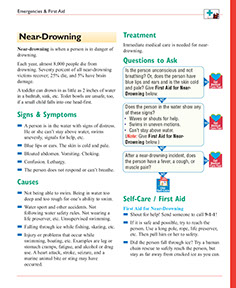First Aid
Near-Drowning
Near-drowning is when a person is in danger of drowning. Each year, almost 8,000 people die from drowning. Seventy percent of all near-drowning victims recover; 25% die, and 5% have brain damage.
A toddler can drown in as little as 2 inches of water in a bathtub, sink, etc. Toilet bowls are unsafe, too, if a small child falls into one head-first.
Signs & Symptoms
• A person is in the water with signs of distress. He or she can’t stay above water, swims unevenly, signals for help, etc.
• Blue lips or ears. The skin is cold and pale.
• Bloated abdomen. Vomiting. Choking.
• Confusion. Lethargy.
• The person does not respond or can’t breathe.
Causes
• Not being able to swim. Being in water too deep and too rough for one’s ability to swim.
• Water sport and other accidents. Not following water safety rules. Not wearing a life preserver, etc. Unsupervised swimming.
• Falling through ice while fishing, skating, etc.
• Injury or problems that occur while swimming, boating, etc. Examples are leg or stomach cramps, fatigue, and alcohol or drug use. A heart attack, stroke, seizure, and a marine animal bite or sting may have occurred.
Prevention
For Children
• Never leave an infant or child alone in any type of bathtub. Supervise young children in the bathroom.
• Never leave a child alone near water, swimming pools, etc. Lock gates to keep children from getting near swimming pools.
• Have a phone near outdoor pools, etc.
• Teach children to swim. Tell them not to swim alone and not to swim too far from shore without a lifeguard or other adult swimmer.
• Put a personal floatation device on each child when near the water or on a boat.
• Tell children to check the depth of water before diving in. It should be at least 9 feet deep.
• Do not allow children to go on untested ice.
• Take CPR and water safety courses.
For Adults
• Learn to swim. Never swim alone at the beach or in a swimming pool. A lifeguard or other adult swimmer should be nearby in case you suffer a leg cramp or other problem.
• Wear a personal floatation device when you are on a boat, when you fish, etc.
• Check the depth of the water before diving in. It should be at least 9 feet deep. Never dive into an above-ground pool.
• Do not use a hot tub or jacuzzi if you’ve had any alcoholic drinks. You could fall asleep, slip under the surface, and drown.
• Take CPR and water safety courses.
Questions to Ask
Question
01
Is the person unconscious and not breathing? Or, does the person have blue lips and ears and is the skin cold and pale? Give First Aid for Near-Drowning under "Self-Care / First Aid".

Get medical care without delay. If symptoms are life threatening go to the ER or call 9-1-1. Don’t call 9-1-1 or use the ER if symptoms do not threaten life. Ask your doctor ahead of time where you should go for a problem that needs prompt care, but not emergency care.
x
Question
02
Does the person in the water show any of these signs?
• Waves or shouts for help.
• Swims in uneven motions.
• Can’t stay above water.
{Note: Give First Aid for Near-Drowning under "Self-Care / First Aid.}

Get medical care without delay. If symptoms are life threatening go to the ER or call 9-1-1. Don’t call 9-1-1 or use the ER if symptoms do not threaten life. Ask your doctor ahead of time where you should go for a problem that needs prompt care, but not emergency care.
x
Question
03
After a near-drowning incident, does the person have a fever, a cough, or muscle pain?

Get medical care without delay. If symptoms are life threatening go to the ER or call 9-1-1. Don’t call 9-1-1 or use the ER if symptoms do not threaten life. Ask your doctor ahead of time where you should go for a problem that needs prompt care, but not emergency care.
x
Self-Care / First Aid
First Aid for Near-Drowning
• Shout for help! Send someone to call 9-1-1!
• If it is safe and possible, try to reach the person. Use a long pole, rope, life preserver, etc. Then pull him or her to safety.
• Did the person fall through ice? Try a human chain rescue to safely reach the person, but stay as far away from cracked ice as you can.
• If you must swim to the person, be sure you are strong and capable enough. Take a flotation device with you. Approach the person from behind in a calm manner. Grab a piece of the person’s clothing. Or, cup one hand under the person’s chin.
• When getting the person out of the water, support the head and neck. (Suspect a neck injury, especially with diving or water sports.)
• CHECK for a response. Give Rescue Breaths and CPR, as needed. If you suspect a spinal injury, use jaw thrust instead of chin-lift for rescue breaths.
• Once out of the water, keep checking the person for a response. Give first aid, as needed.
• Put the person in the Recovery Position. Immobilize the person as much as possible. If the person is vomiting, clear his or her mouth of it.
• Remove cold, wet clothes. Cover the person with a blanket, etc.

Download an offline pdf file.
RELATED ARTICLES
<
>
2021 © American Institute for Preventive Medicine - All Rights Reserved. Disclaimer | www.HealthyLife.com








